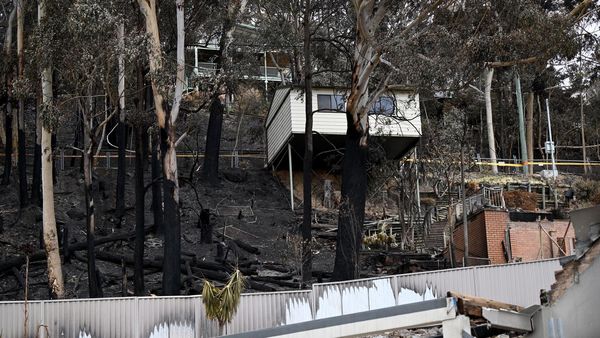
Head in hand, Käthe Kollwitz leans towards you out of the darkness. Her face is so superbly drawn you sense the nerve and bone beneath the life-worn surface. There are the deep-set eyes and snub nose familiar from more than 100 self-portraits, but this one presses so close to the viewer it is as if Kollwitz has passed directly through the picture plane and is breathing the very same air – an image the size of life, and fully as profound.
Kollwitz (1867-1945) is the most famous of the four artists brought together in Making Modernism at the Royal Academy. Yet even she – for all her graphic genius, working entirely in drawing and democratic print, cheaper to buy, easier to transport than any painting – is somewhat stinted in the world’s museums.
More people have seen the work of Paula Modersohn-Becker in reproduction – specifically her epochal nude self-portrait of 1906 – than have ever seen it in reality. Their German compatriot Gabriele Münter is the forgotten member of the Blue Rider group, and the Russian-born Marianne Werefkin is possibly the least known of all the founding expressionists whose contribution to German modernism is this show’s subject.

So why are these artists (and a handful of others) shoehorned into three small rooms at the back of the RA when William Kentridge has the grand canyon of all 13 main galleries upstairs? And how can such a constrained display cost £17 a head: an outrageous price for knowledge? The curators have very skilfully woven the works together by theme – self-portraiture, mothers and children, society and so on – but their excellent catalogue suggests that they could have filled the rooms many times over, not least with solo exhibitions.
Who, for instance, has ever painted quite like Paula Modersohn-Becker (1876-1907)? Her pictures of herself, breaking away from a middle-class marriage at the turn of the century, standing nude with one hand on her swelling stomach (she wasn’t yet pregnant) or filling the frame with her huge-eyed face, frontal as a Fayum portrait, are all sensuous strength and certainty.
She stands before a backdrop of Parisian facades, a dense, dark face haloed in their silvery grey, as if she had recruited the whole city to her cause. She paints a mother balancing a child in the crook of her arm, both of them naked, each holding a fruit that rhymes with the blush of a cheek, the shape of a breast, the snugness of a round body in its healthy skin.
There is a wonderful image here of two female hands clasping a chamomile flower that defies all the era’s ladylike conventions: both the blossom and the hands have a compact sturdiness – a natural force – that is anything but dainty.

Even in no more than 20 paintings, you sense her restless energy running through continuous experiments. The surfaces are layered, nubbed, smoothed and caressed, the warm paste matching the living bodies. A portrait of an Italian girl is painted like some great Italian fresco – the pure contours of a Piero della Francesca, say – except that the pigment is brimming over, bodying forth like substantial flesh.
Modersohn-Becker gave birth to a daughter in 1907 and was kept on bed rest for the following 18 days. As soon as she was allowed to get up, she dropped down dead of an embolism. Seven hundred works remain, most of them in a dedicated museum in Bremen, so this is a vital chance to see her paintings in the UK. Had she lived, the history of art would not have been the same.
Her contemporary Gabriele Münter (1877-1962) travelled three continents, spoke five languages and was an early adept with the Kodak camera. She paints in lush strokes of brilliant colour, often quite flat – as with her Blue Rider landscapes – but always with a direct and even mirthful candour.
Here are her portraits of friends at home. Her lover Wassily Kandinsky: bare knees, wearing what look like leg warmers, half-awake in bed or yattering across the tea table. His sandals are positioned on the floor by a cheerful rag rug; and here are the identical sandals this time worn by Paul Klee, his square head surrounded by framed folk art on the wall.
Something of Münter’s spirit is surely apparent in a closeup of shopping in the lap of a passenger sitting opposite – bright parcels, a geranium, a bag embroidered with a fizzing yellow lemon. The witty title she gives this transport of a painting is Still-life on the Tram.

Her friend Marianne Werefkin goes even further with the humour. Her 1909 portrait of four drinkers, glum-faced and rancorous over the absinthe, is like a send-up of blue period Picasso. A resentful couple on a bench, apparently oblivious to the mountains all around them, is titled Life Behind Them.
Werefkin (1860-1938), who lived with the painter Alexei Jawlensky until he left her for the housekeeper, seems to paint from an explicitly feminist viewpoint. At least that is how one might interpret her images of the black-clad women in the mountains of southern Switzerland where she eventually made her home. Burdened with babies, firewood, baskets of food, buckets of water – all the stuff of life – they shoulder their way down the steep streets. Only once is there a man in sight.
The curators have allowed a subtle counterpoint between Werefkin’s Twins – two nannies with arsenical green faces, paying no heed to their infant charges – and Kollwitz’s sublime drawing of the same title. Made on tracing paper as crumpled as the sheet on which they perhaps once lay, this crayon drawing of identical twins records both their closeness, the bodies nearly united in one, and the double-take of their sleeping heads. The eye runs back and forth between them like a parent, noticing every similarity, and every difference.

If there is one shared trait among these artists it is this sense of proximity, intimacy, closeness. You see this particularly in the astounding tenderness of Kollwitz’s maternal drawings. A woman presses a baby to her face, a newborn not much bigger than the size of her own head, as if treasured in mind. Another cradles a dead child, her face buried in his poor young body. Never let me go.
Most exquisite is a pencil drawing of a mother’s hands holding the head of her child. The hands are gently shaped to enfold the head just as instinctually as her body once did, carrying the child before it was born. The child is ethereal, eyes shut as if asleep, or even dead. Kollwitz knew poverty, hunger and infant mortality first-hand, living through two world wars. Her son died in the first, her grandson in the second. “Drawing,” she wrote, of her incomparable art, “is the only thing that makes my life bearable.”
Making Modernism is at the Royal Academy, London, until 12 February 2023







